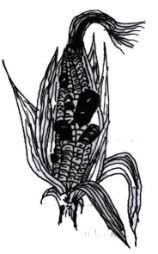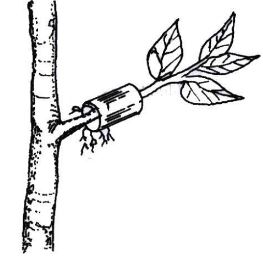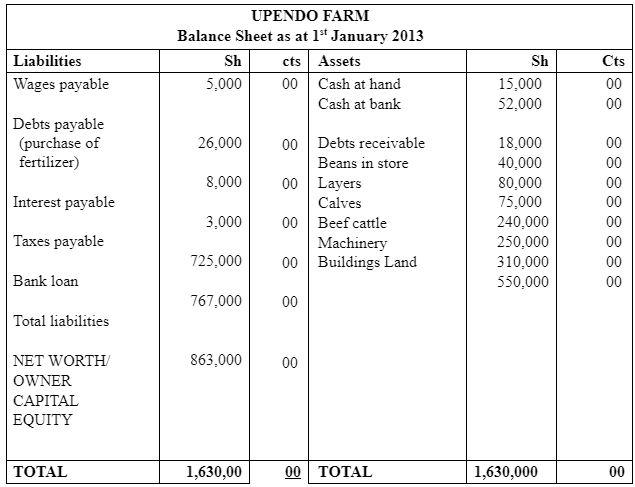INSTRUCTIONS TO CANDIDATES
- This paper consists of three sections: A, B and C.
- Answer all the questions in section A and B and any two questions from section C.
SECTION A (30 marks)
- State four reasons why agriculture is important to Kenya’s economy. (2 marks)
- State four ways in which mulching conserves water. (2 marks)
- State four ways in which trees improve soil productivity. (2 marks)
- What is meant by the term integrated pest management? (2 marks)
- State four factors that influence soil formation. (2 marks)
- State four causes of crop diseases. (2 marks)
- State four ways in which a land title deed is important to a farmer. (2 marks)
- Give four agents of soil erosion. (2 marks)
- Give four reasons for intercropping in crop production (2 marks)
- State four characteristics of extensive farming system. (2 marks)
- Outline four minimum tillage practices (2 marks)
- Give four reasons why burning of land is discouraged. (2 marks)
- State four functions of Young Farmers Club (2 marks)
- Distinguish between a perfect and an imperfect market. (1 mark)
- State the meaning of the following terms as used in crop production.
- Crop rotation. (1 mark)
- Pruning. (1 mark)
- Rogueing. (1 mark)
SECTION B (20 marks)
- A farmer has a piece of land on which he can grow maize, cabbages and beans. The expected yields and selling prices of the three crops are shown below.
If the cost of producing any of the three crops is the same.Crop Yield (kg) Selling prices (ksh/kg) Maize 4000 40 Cabbages 2800 60 Beans 3000 80 - Which crop should the farmer grow? Show your working. (2 marks)
-
- State the farmer’s opportunity cost. (1 mark)
- Give a reason for your answer in (b) (i) above. (1 mark)
- Give a reason why farmers always have to make a choice on the enterprise to implement on the farm. (1 mark)
- A famer is advised to apply 60kg N, 20kg P2O5 and 30kg K2O per hectare. Calculate the quantity of urea (46%N), single super phosphate (20%P2O5) and muriate of potash (50% K2O) the farmer should apply on his 10 hectares land. (5 marks)
- Below is a diagram showing a crop disease.
- Identify the crop disease. (1 mark)
- State three control measures for the crop disease. (3 marks)
- Name the category in which the crop disease is classified. (1 mark)
- The diagram below illustrates a nursery practice.
- Identify the practice. (1 mark)
- Describe the procedure followed in carrying out the practice illustrated. (2 marks)
- State two advantages of the practice illustrated above in crop production. (2 marks)
SECTION C (40 marks)
-
- Describe seven harmful effects of crop pests. (7 marks)
- Describe eight safety measures a farmer should observe when using herbicides to control weeds. (8 marks)
- Describe the harvesting of coffee. (5 marks)
- Explain five factors that can increase the demand for tea on a market. (10 marks)
- State four ways of improving labour productivity on the farm (4 marks)
- The following information was obtained from Upendo Farm inventory on 1st January2013.
On the same day the farm recorded the following;ITEM VALUE(Ksh) Layers 80,000 Beef cattle 240,000 Beans in store 40,000 Cash at hand 15,000 Land 550,000 Machinery 250,000 Buildings 310,000 Calves 75,000
Using the information provided prepare a balance sheet for Upendo Farm. (6 marks)ITEM VALUE(Ksh) Wages payable 5,000 Interest payable 8,000 Bank loan 725,000 Milk sales on credit 12,000 Chicken sales on credit 6,000 Cash in bank 52,000 Purchase of fertilizer on credit 26,000 Taxes payable 3,000
-
- Describe the field management practices for tomatoes. (10 marks)
- Explain ways in which the Kenyan Government can improve maize production to ensure food security in the country. (10 marks
MARKING SCHEME
SECTION A( 30 marks)
- State four reasons why agriculture is important to Kenya’s economy. (2 marks)
- Source of food
- Source of employment
- Provision of raw materials for industries
- Provide market for industrial goods
- Source of income
- State four ways in which mulching conserves water. (2 marks)
- Prevents splash erosion/intercepts rain drops Reduces speed of surface run offs
- Reduces evaporation
- Increases water holding capacity
- Improves water infiltration
- State four ways in which trees improve soil productivity. (2 marks)
- Conserve moisture
- Improve soil structure
- Control soil erosion
- Contribute plant nutrients/organic matter
- Is a combination of chemical, physical, biological and cultural
- What is meant by the term integrated pest management? (2 marks)
- Is a combination of chemical, physical and cultural pest control methods.
- State four factors that influence soil formation. (2 marks)
- Parent rock/ bed-rock
- Climate
- Topography/ slope
- Time
- Living organism/ biotic factors
- State four causes of crop diseases. (2 marks)\
- Fungi
- Virus
- Bacteria
- Poor weather conditions/ physiological conditions
- Lack of essential elements/ nutritional imbalances
- State four ways in which a land title deed is important to a farmer. (2 marks)
- Used to secure credit facilities for land development
- Land disputes are minimized
- Encourage farmer to carry out long term investment on the land
- Enables owner to lease the farm and thus get extra income
- Provide security of ownership
- State four agents of soil erosion. (2 marks)
- Water
- Wind
- Human activities
- Living organisms/ animals
- Give four reasons for intercropping in crop production (2 marks)
- Controls erosion through cover cropping.
- Nitrogen fixation when leguminous crops are included.
- Smothers weeds;
- Diversification/spread risks ➢ Improves soil structure ➢ Maximize use of labour.
- Control pests and diseases
- Maximize utilization of land/high yield per.
- State four characteristics of extensive farming system. (2 marks)
- Low capital investments
- Large pieces of land
- Low labour required
- Low levels of management - Common in marginal area - Low production per unit area.
- Outline four minimum tillage practices (2 marks)
- Uprooting/slashing
- Use of cover crops
- Limiting cultivation to the point of planting / restrict cultivation to the base of the plant.
- Proper timing of cultivation
- Mulching
- Use of herbicides
- Give four reasons why burning of land is discouraged. (2 marks)
- Kills soil living organisms
- Leads to loss of soil moisture
- Destroys soil structure
- Destroys soil organic matter
- Destroys plant nutrients
- Causes mineral imbalances through ash-accumulation ➢ Leads to soil erosion.
- State four functions of Young Farmers Club (2 marks)
- Involvement in agricultural projects at club level
- Participation in annual rallies
- Involvement in seminars and workshops related to agriculture
- Participating in national tree planting activities
- Participation in national ploughing contests
- Participation in exchange programmes
- Participation in ASK shows
- Distinguish between a perfect and an imperfect market. (1 mark)
- Perfect market – Is where a buyer can purchase from any seller and vice versa / there are many buyers and sellers of a commodity. Buyers and sellers are aware of prices offered by others.
- Imperfect market - is where some buyers and sellers are not aware of prices offered by other sellers /where there are a few sellers/buyers of a commodity. (mark as a whole)
- State the meaning of the following terms as used in crop production.
- Crop production. (1 mark)
- Is the growing of different types of crops or crops of different families on the same piece of land in an orderly sequence
- Pruning. (1 mark)
- Removal of extra or unwanted parts of a plant.
- Rogueing. (1 mark)
- Is the uprooting and destruction of plants attacked by pests, disease to prevent spread.
SECTION B(20 Marks)
- Is the uprooting and destruction of plants attacked by pests, disease to prevent spread.
- Crop production. (1 mark)
- A farmer has a piece of land on which he can grow maize, cabbages and beans. The expected yields and selling prices of the three crops are shown below.
If the cost of producing any of the three crops is the same.Crop Yield (kg) Selling prices (ksh/kg) Maize 4000 40 Cabbages 2800 60 Beans 3000 80 - Which crop should the farmer grow? Show your working. (2 marks)
- Maize – 4000 x 40 = 160,000/- 1 mark
- Cabbages – 2800 x 60 = 168,000/- 1 mark
- Beans – 3000 x 80 = 240,000/- 1 mark
➢ The farmer should grow beans.
-
- State the farmer’s opportunity cost. (1 mark)
- (168,000/-)
- Give a reason for your answer in (b) (i) above. (1 mark)
- It is the value of the best alternative forgone
- State the farmer’s opportunity cost. (1 mark)
- Give a reason why farmers always have to make a choice on the enterprise to implement on the farm. (1 mark)
- Resources are limited while possible enterprises are unlimited
- Which crop should the farmer grow? Show your working. (2 marks)
- A famer is advised to apply 60kg N, 20kg P2O5 and 30kg K2O per hectare. Calculate the quantity of urea (46%N), single super phosphate (20%P2O5) and muriate of potash (50% K2O) the farmer should apply on his 10 hectares land. (5 marks)
- Option I
- Urea
46kg N are in 100kg urea
60kg N are in 60 x 100
46
= 130.435kg Urea
1 ha = 130.435kg
10 ha = 130.435 x 10
= 1304.35kg Urea. - SSP
20kg P2O5 are in 100kg SSP.
20kg P2O5 are in 20 x 100
20
= 100kg SSP 1 ha = 100kg SSP
10ha = 100 ? 10
1
= 1000kg SSP - KCL
50kg K2O are in 100kg Kcl
30 K2O are in 30 x 100
50
= 60kg Kcl
1 ha = 60kg Kcl
10 ha = 60 x 10
1
= 600kg Kcl.
- Urea
- OPTION II
- Urea
1 ha requires 60kg N
10 ha will require 10 x 60
1
= 600kg N 46kg N are
100kg urea
600kg = 600 x 100
46
= 1304.35kg Urea. - SSP
1 ha requires 20kg P2O5 10ha require
10 x 20
1
= 200kg P2O5
20kg are in 100kg SSP
200kg P2O5 are in 200 x 100
20
= 1000kg SSP - KCL
1 ha requires 30g K2O
10 ha requires
= 300kg K2O
50kg K2O are in 100kg Kcl
300 K2O are in 300 x 100
50
= 600kg Kcl.
- Urea
- Option I
- Below is a diagram showing a crop disease.
- Identify the crop disease. (1 mark)
- Maize/smut
- State three control measures for the crop disease. (3 marks)
- Ensure field hygiene.
- Use of resistant varieties;
- Rogueing
- Crop rotation.
- Use of certified seeds
- Name the category in which the crop disease is classified. (1 mark)
- Fungal disease.
- Identify the crop disease. (1 mark)
- The diagram below illustrates a nursery practice.
- Identify the practice. (1 mark)
- Aerial layering/marcotting
- Describe the procedure followed in carrying out the practice illustrated. (2 marks)
- Select a healthy woody branch.
- Remove the bark and cambial layer from a section of the branch / debarking the branch.
- Heap moist rooting medium around the section.
- Wrap the rooting medium with a polythene sheet. 4 x ½ marks 2 marks
- State two advantages of the practice illustrated above in crop production. (2 marks)
- It is used to propagate plants whose branches cannot bend easily to the ground / stem/ high up stems.
- It is used to obtain large planting materials.
SECTION C (40 marks)
- Identify the practice. (1 mark)
-
- Describe seven harmful effects of crop pests. (7 marks)
- Feed on whole or parts of plants
- Some unearth planted seeds
- Deprive the plant of food by sucking sap
- Lower the quality of flowers, fruits and berries
- Eat growing points of plants causing stunted growth
- Feed on whole or parts of seeds and lower germination percentage
- Lower the yield expected
- Cause wilting of plants by feeding on the roots
- Reduce the surface area for photosynthesis by feeding on leaves
- Chemical pest control measures affect the environment
- Cause injuries that lead to secondary infection
- Increase the cost of production during control.
- Transmit crop diseases
- Describe eight safety measures a farmer should observe when using herbicides to control weeds. (8 marks)
- Read and follow manufacturer’s instructions
- Wear protective clothing
- Avoid inhaling the herbicide/not spraying against the wind/wearing breathing masks/not smoking.
- Avoid eating before bathing.
- Bath thoroughly after handling herbicides.
- Avoid blowing/sucking blocked nozzles.
- Avoid contamination of animal feeds and water
- Leftovers and empty containers should be properly disposed off and not thrown in gardens, bushes or pastures;
- Equipment used should not be washed in water sources used by animals and humans.
- Store the chemicals safely out of reach of children and away from food.
- Thoroughly wash the equipment used. - Label the chemical containers well.
- Describe the harvesting of coffee. (5 marks)
- Ripe cherries are picked by hand.
- Harvested cherries are spread on mats and sorted to remove unripe, diseased, dry and damaged berries.
- The diseased and overripe cherries are taken to factories as grade II.
- Good quality cherries are taken to the factory as grade I.
- Unripe, dry and overripe cherries are dried at home to form Buni.Buni is taken to the factory at the end of the harvesting season.
- Pick up at 7 – 14 days interval.
- Deliver grade I & II to the factory same day.
- Describe seven harmful effects of crop pests. (7 marks)
-
- Explain five factors that can increase the demand for tea on a market. (10 marks)
- Population increase leads to increased consumption of tea;
- Increase in income of tea consumers.
- Increase in preference and taste for tea.
- Increase in the price of related goods/substitutes.
- Advertisement promotes the sale of tea.
- Future expectations of uncertainty e.g. shortage makes consumers to buy and stock.
- Improved quality of tea;
- Price expectation i.e future increase in the price increases the demand for tea;
- Reduced taxation makes it affordable to more consumers. Factor 5 x 1; explanation 5 x 1 = (10 marks)
- State four ways of improving labour productivity on the farm (4 marks)
- Training;
- Giving incentives/improving terms and conditions of service.
- Farm mechanization.
- Labour supervision.Proper remuneration/payment.
- Assigning tasks according to skills. (4 marks)
- The following information was obtained from Upendo Farm inventory on !st January2013.
On the same day the farm recorded the following;ITEM VALUE(Ksh) Layers 80,000 Beef cattle 240,000 Beans in store 40,000 Cash at hand 15,000 Land 550,000 Machinery 250,000 Buildings 310,000 Calves 75,000
Using the information provided prepare a balance sheet for Upendo Farm. (6 marks)ITEM VALUE(Ksh) Wages payable 5,000 Interest payable 8,000 Bank loan 725,000 Milk sales on credit 12,000 Chicken sales on credit 6,000 Cash in bank 52,000 Purchase of fertilizer on credit 26,000 Taxes payable 3,000
Correct heading 1 mark
Correct columns 1 mark
Correct entries 2 x 1 mark
Net worth 1 mark
Total 1 mark
- Explain five factors that can increase the demand for tea on a market. (10 marks)
-
- Describe the field management practices for tomatoes. (10 marks)
- Watering early in the morning and late in the evening during dry weather conditions.
- Gapping to ensure optimum plant population/ replace seedlings that have dried.
- Weed control to reduce competition/ any other reason to weed control/ any effective method of weed control.
- Mulching to conserve moisture and smother weeds/ any other reason for mulching.
- Staking to support the plants off the ground to prevent funga diseases.
- Top dressing CAN or SA/20kg N per per ha.
- Pruning to control upward growth and encourage development of large fruits/any relevant reason for pruning/method of pruning.
- Pest control using appropriate pesticides to preven destruction of plants/ flowers and fruits/improve quality of fruit/any specific pest.
- Disease control – spray with appropriate fungicides to control tomato blight and pest control e.g Ameriacn bollworm, cutworm, white fly, Red spider, mites e.t.c by using suitable insecticides.
- Explain ways in which the Kenyan Government can improve maize production to ensure food security in the country. (10 marks)
- Extension and training; provision of extension services to advise farmers on modern maize production techniques e.g. irrigation, use of certified seeds, pests and disease control.
- Provision of subsidies on farm inputs e.g. fertilizers to reduce the cost of production.
- Provision of credit facilities e.g through AFC, to finance maize farming operations.
- Imposing high taxation on imported maize and maize products to discourage importation and protect local farmers.
- Quality control to ensure production of high quality maize that can attract foreign markets.
- Supporting research into new and improved varierties of maize for high yields.
- Farm input supplies.
- Provision of marketing services
- Provision of drying and storage facilities.
- Provision of tractor hire services.
- Ensures effective pest, diseases and weed control.
- Effective soil and water conservation.
- Setting up irrigation projects in dry areas to increase production. 10x1 marks
- Describe the field management practices for tomatoes. (10 marks)
Download Agriculture Paper 1 Questions and Answers - Lanjet Joint Mock Exams 2023.
Tap Here to Download for 50/-
Get on WhatsApp for 50/-
Why download?
- ✔ To read offline at any time.
- ✔ To Print at your convenience
- ✔ Share Easily with Friends / Students



